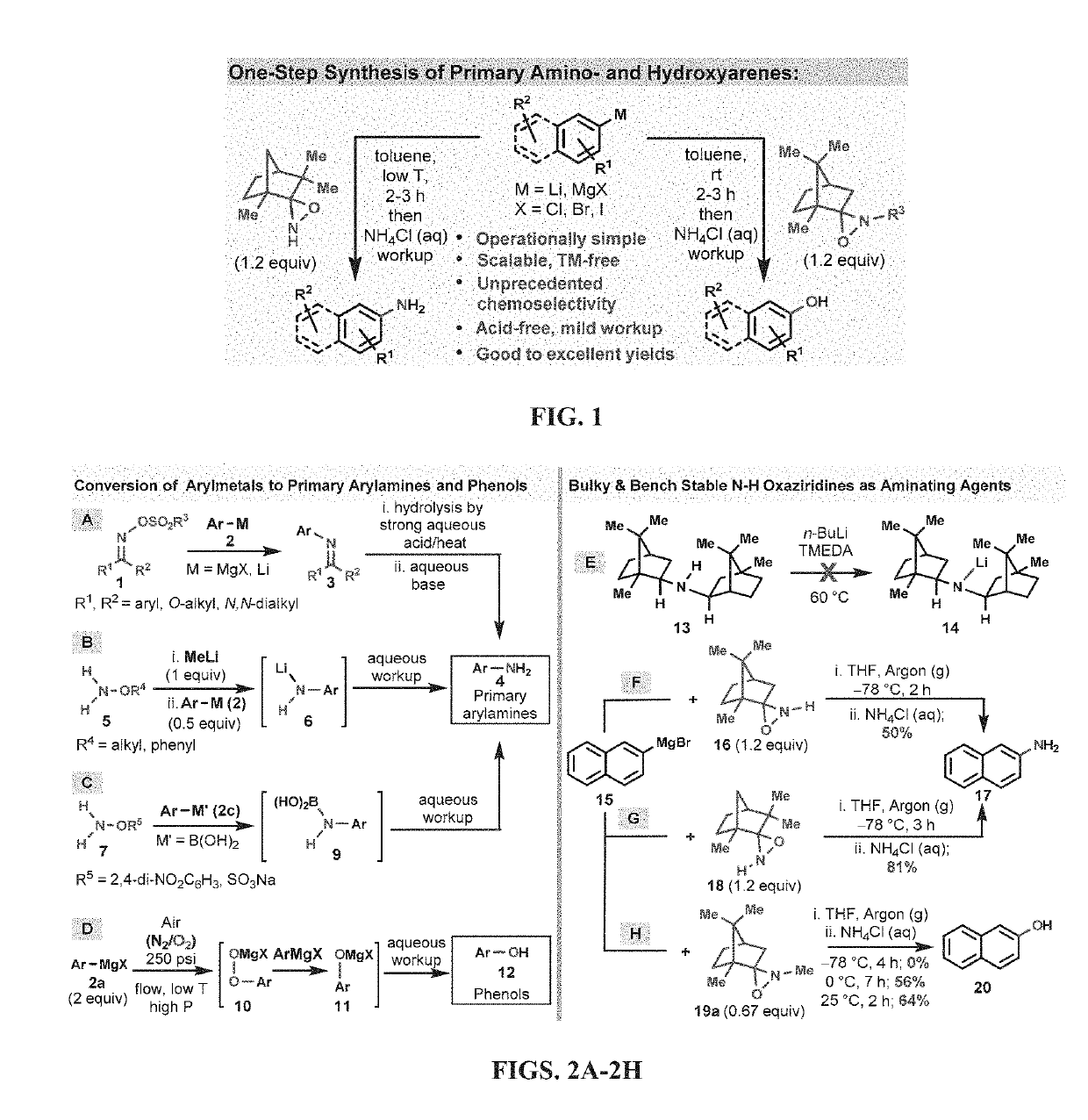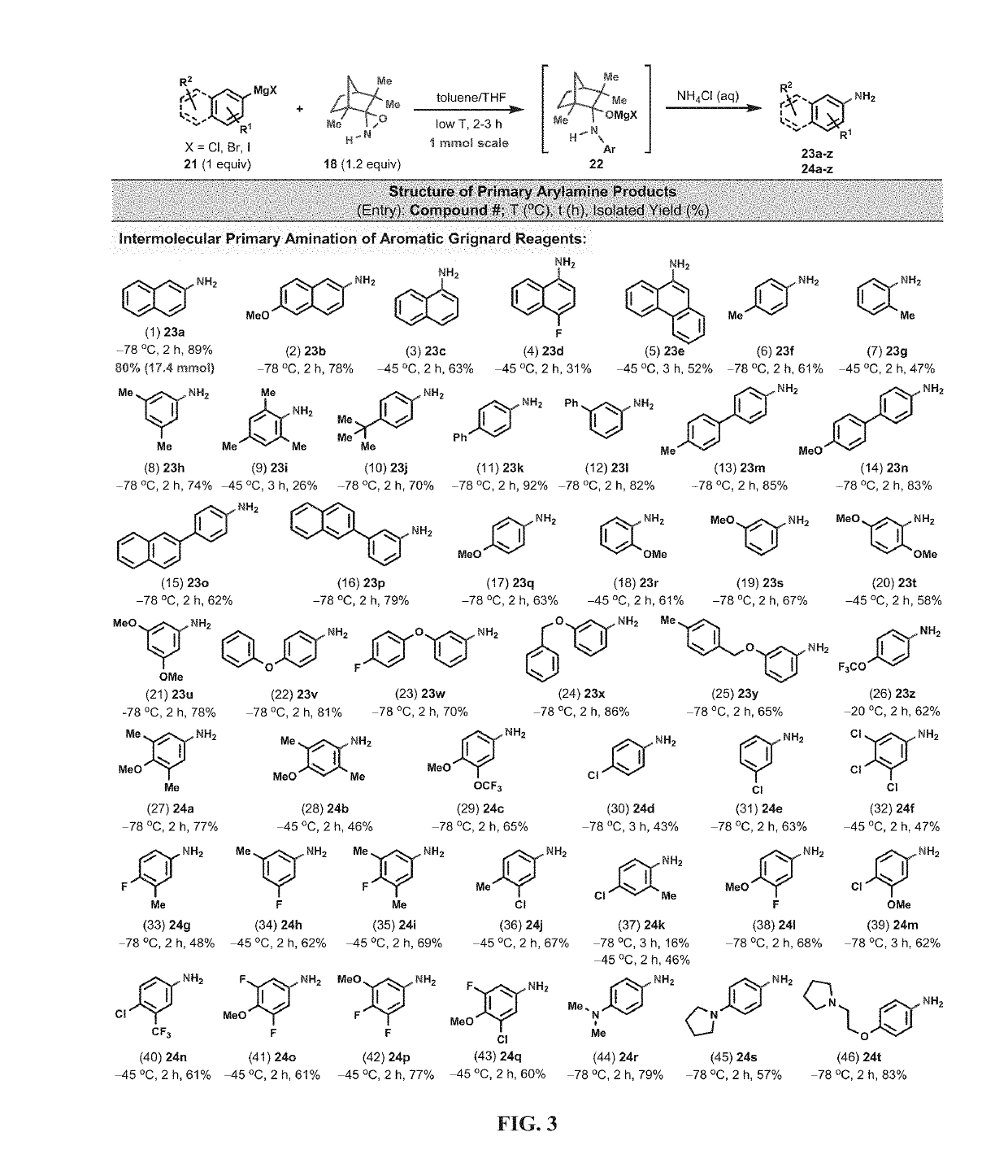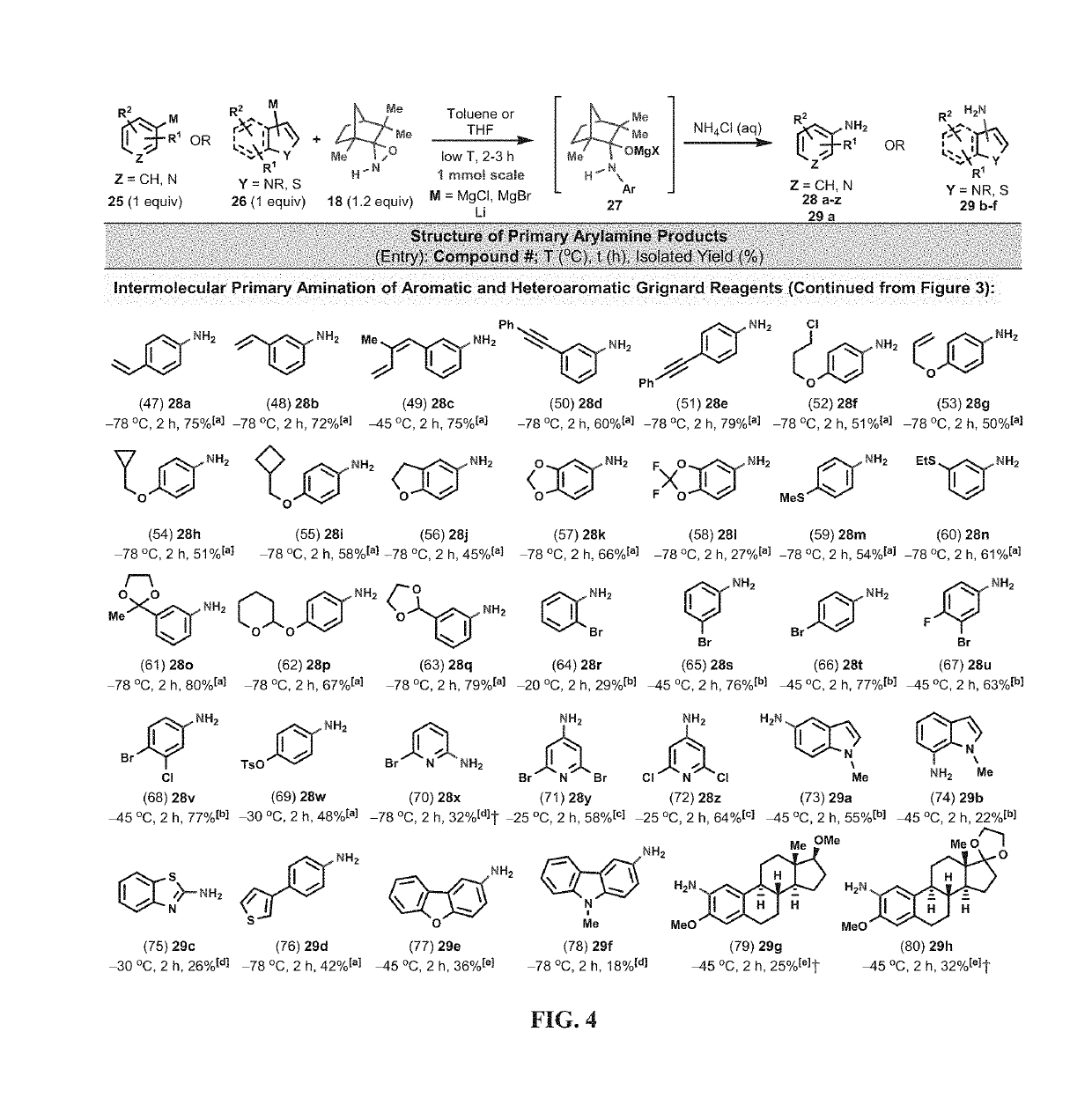Amination and hydroxylation of arylmetal compounds
a technology of arylmetal compounds and amination, which is applied in the preparation of amino-carboxyl compounds, organic chemistry, sulfonic acid esters, etc., can solve the problems of limited functional group tolerance, poor yield of primary arylamine, and excessive problem of direct primary amination of arylmetal reagents
- Summary
- Abstract
- Description
- Claims
- Application Information
AI Technical Summary
Benefits of technology
Problems solved by technology
Method used
Image
Examples
example 1
of Arylmetal Compounds
[0105]Given that highly sterically hindered secondary amines tend to be resistant to N—H deprotonation (Corey and Gross, 1985), even in the presence of excess alkyllithium reagents at elevated temperatures, (FIG. 2, E), N—H oxaziridines, such as 16 and 18, were tested for their potential to undergo amination moiety with arylmetal reagents faster than the deprotonation of the N—H functionality of the N—H oxaziridines. The camphor-derived N—H oxaziridine 16 was found to be an efficient N—H-transfer agent and reacted smoothly with 2-naphthylmagnesium bromide (15) to afford, after simple aqueous workup, the corresponding 2-naphthylamine (17) directly in its unprotected free-base form (FIG. 2, F). With this reaction method, the use of either a large excess of aminating reagent (16) or arylmetal substrate (15) was not required in order to obtain a synthetically useful isolated yield (50%; 1 mmol scale) in this direct primary amination reaction. The main side product ...
example 2
bstituted Arylmetals
[0110]The direct N-alkyl-transfer, a highly coveted transformation, was also a possibility by utilizing the N-alkyl versions of oxaziridines 16 and 18. Unfortunately, the N-Me oxaziridine 19a (the N-Me analogue of 16) did not react at all with 2-naphthylmagnesium bromide (15) at −78° C. However, at 0-25° C., the N-Me oxaziridine acted as an effective O-transfer agent and converted 15 to the corresponding phenol 20 in good isolated yield (FIG. 2, H). Analysis of the reaction mixture revealed that the oxygen transfer was exclusive and none of the N-transfer product could be detected by LC-MS analysis. A control experiment under argon atmosphere, and in the absence of 19, led to the formation of only trace amounts of 20, indicating that the origin of oxygen atom in phenol 20 is the oxaziridine (19) and not the adventitious oxygen (02) from air.
[0111]For the direct hydroxylation of arylmetals, several N-alkyl oxaziridines have been prepared and evaluated. N-Benzyl ox...
example 3
Condition Optimization
[0112]
[0113]
TABLE 1Reaction Condition Optimization for Amination ReactionEquiv EquivAddi-Tem-Yield En-ofoftivesSol-per-of try21aNH1.2 equivventatureTime23a12.016, 1.0—THF−45° C.1 h59%22.016, 1.0—THF−78° C.5 h58%32.016, 1.0—THF−78° C.1 h43%42.016, 1.0—THF 0° C.1 h25%51.516, 1.0—THF−45° C.1 h54%61.016, 1.5—THF−45° C.1 h65%71.016, 1.5—THF−45° C.2 h57%81.016, 1.2—THF−78° C.2 h50%91.016, 1.2—THF−45° C.2 h63%101.016, 1.2TMEDATHF−45° C.2 h42%111.016, 1.2DMPUTHF−45° C.2 h45%121.016, 1.2HMPATHF−45° C.2 h46%131.016, 1.5—Et2O−45° C.2 h43%141.016, 1.5—Toluene−45° C.2 h41%151.016, 1.5—CH2Cl2−45° C.2 h33%161.018, 1.2—THF−45° C.2 h77%171.018, 1.2—THF−78° C.2 h81%181.018, 1.2—THF −0° C.2 h68%191.018, 1.5—THF−45° C.2 h69%201.018, 1.5—THF−78° C.2 h68%211.018, 1.2—Et2O−78° C.2 h76%221.018, 1.2—Toluene−78° C.2 h89%231.018, 1.2—CH2Cl2−78° C.2 h83%241.030, 1.2—Toluene−78° C.2 h83%251.031, 1.2—Toluene−78° C.2 h46%
[0114]
TABLE 2Optimization of the Hydroxylation Reaction ConditionsEntry...
PUM
| Property | Measurement | Unit |
|---|---|---|
| temperature | aaaaa | aaaaa |
| temperature | aaaaa | aaaaa |
| temperature | aaaaa | aaaaa |
Abstract
Description
Claims
Application Information
 Login to View More
Login to View More - R&D
- Intellectual Property
- Life Sciences
- Materials
- Tech Scout
- Unparalleled Data Quality
- Higher Quality Content
- 60% Fewer Hallucinations
Browse by: Latest US Patents, China's latest patents, Technical Efficacy Thesaurus, Application Domain, Technology Topic, Popular Technical Reports.
© 2025 PatSnap. All rights reserved.Legal|Privacy policy|Modern Slavery Act Transparency Statement|Sitemap|About US| Contact US: help@patsnap.com



